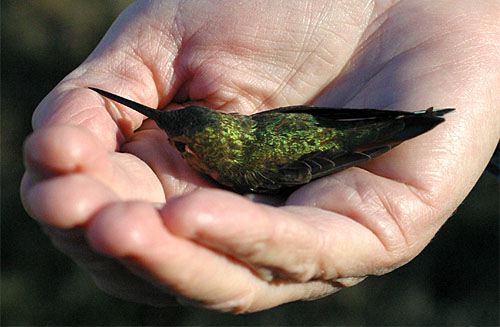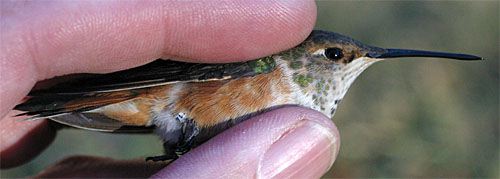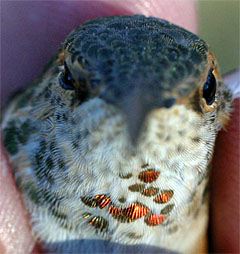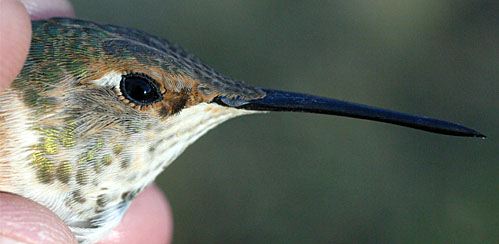|
|
|||
|
RUFOUS HUMMINGBIRD |
|
All text & photos © Hilton Pond Center After banding a young male Rufous Hummingbird at Spartanburg SC on 22 December 2003, we headed up I-26 to Columbus, just across the border into North Carolina. We had journeyed to this Polk County mountain town in late October to band a hatch-year male Rufous at the home of old friends Luanne and Buren Blankenship, and interestingly enough, their yard was being visited sporadically by another apparent Rufous that showed up on about 1 December. By mid-month the bird was coming regularly to the feeder, so we made plans to drop by the Blankenship home for another banding foray.
We arrived at Columbus by 8:45 a.m., moved the Blankenship feeder into our portable trap, and hung the whole apparatus by 8:50 a.m., after which we retired to the dining room for conversation and a fine snack of cheese and homemade dried apples. We didn't have long to talk or eat, however, because a hummingbird--obviously not the partly rusty male we had banded in October--came in to investigate the trap. By 8:58 a.m., hunger got the best of the bird and it flew in through the open trapdoor. Just as we reached up to open the trap's access door, another hummer dived down and--from a distance of six inches or less--buzzed around our right ear. Since we don't have eyes in the sides of our head, we couldn't actually see this second bird, but the Blankenships both said it was very green on the back and tail and must be a newcomer. The second bird buzzed away as quickly as it had come, so we removed the captured individual and quickly re-set the trap in the hope of scoring a double at the Blankenship home.
Each of the Blankenships kept one eye on the handling process and one on the trap hanging outside, but even after we banded and released the first bird, the second one failed to reappear.
Since we had gotten an E-mail message from another Columbus homeowner who was hosting a winter hummingbird, we suspect the second bird was feeding elsewhere while we were banding at the Blankenships. Unfortunately, a quick phone call to the other home went unanswered, so we couldn't verify our hypothesis. After unsuccessfully waiting for an hour or so for any hummers to re-appear, we departed the Blankenships' with a vow to return to Columbus after the holidays to see if they indeed were sharing a bird with another hummingbird enthusiast less than half a mile away.
Vital Statistics for All text & photos © Hilton Pond Center POSTSCRIPT: This bird was retrapped at the Blankenship residence on 26 November 2004.
If you're interested in sharing your hummingbird observations and learning from other enthusiasts, you may wish to subscribe to Hummingbird Hobnob, our Yahoo!-based discussion group. Also be sure to visit our award-winning Web site for Operation RubyThroat: The Hummingbird Project; on it you'll find almost anything you want to know about hummingbirds, including more information about Hummingbird Banding.
For much more information about hummingbirds, visit Operation RubyThroat: The Hummingbird Project  |
|
Make direct donations on-line through
Network for Good: |
|
|
LIKE TO SHOP ON-LINE?
Donate a portion of your purchase price from 500+ top on-line stores via iGive: |
|
|
Use your PayPal account
to make direct donations: |
|
 post questions for The Piedmont Naturalist |
Join the |
Search Engine for |
|
|



 A click of the remote snared it, and we all went back outside to remove the hummer for banding.
A click of the remote snared it, and we all went back outside to remove the hummer for banding. In the hand, the first hummer showed considerable rustiness at the base of the tail (left), indicating it was a Selasphorus--either a Rufous Hummingbird (S. rufus) or Allen's Hummingbird (S. sasin). Based on our measurements of the wing, tail, and exposed bill, we determined it was the somewhat larger Rufous, and a female. Because of the shape of the tail feathers and lack of tiny bill etchings, we also concluded it was an adult that hatched out sometime prior to 2003, undoubtedly in southern Alaska, western Canada, or the northwestern U.S.
In the hand, the first hummer showed considerable rustiness at the base of the tail (left), indicating it was a Selasphorus--either a Rufous Hummingbird (S. rufus) or Allen's Hummingbird (S. sasin). Based on our measurements of the wing, tail, and exposed bill, we determined it was the somewhat larger Rufous, and a female. Because of the shape of the tail feathers and lack of tiny bill etchings, we also concluded it was an adult that hatched out sometime prior to 2003, undoubtedly in southern Alaska, western Canada, or the northwestern U.S.


 Students at GLOBE-certified schools may submit winter hummingbird observations as part of Operation RubyThroat and GLOBE. Students can also correlate hummingbird observations with data on abiotic factors, including atmosphere, climate, hydrology, soils, land cover, and phenology. See the
Students at GLOBE-certified schools may submit winter hummingbird observations as part of Operation RubyThroat and GLOBE. Students can also correlate hummingbird observations with data on abiotic factors, including atmosphere, climate, hydrology, soils, land cover, and phenology. See the 

